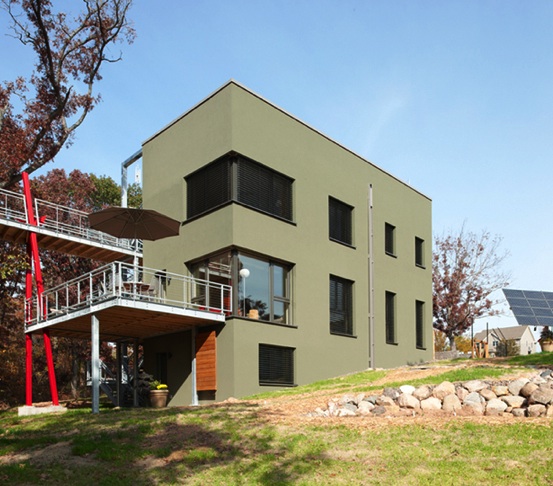
The owner of a celebrated Passivhaus in Wisconsin will be making a lot less money for the excess electricity generated by his photovoltaic panels thanks to an about-face in policy by the local electric cooperative.
GBA readers will be familiar with Passive House in the Woods, a 1,940-sq. ft. house completed in Hudson, Wisconsin, in 2010 and documented not only in a blog written by its designer Tim Eian but also in several news stories by GBA’s Richard Defendorf.
Gary Konkol, who owns the house, has been notified by the St. Croix Electric Cooperative that he will no longer receive the retail rate for power generated by his 4.52 kW PV system. Instead, the cooperative is prepared to pay the “avoided cost” of the electricity, which is based on the cost to the utility of buying or generating the power.
The policy change, which was announced in May, will have the effect of lowering payments to Konkol and other cooperative customers with PV systems from 10 or 11 cents per kWh to between 2.75 and 3.75 cents per kWh, according to an article that originally appeared in Midwest Energy News. (This change only affects the price paid for any PV power exceeding the owner’s usage.)
The new policy is an about-face
“Unfortunately, the terms of service and rate issue has become a few members’ personal interests versus all the other cooperative members’ interests,” Cooperative president and CEO Mark Pendergast told Energy News.
Konkol’s house has been generating enough electricity during the summer to cover the cost of power during the winter, so he’s been paying only the $25 monthly service charge, due to rise to $28 in January.
But even the new fee won’t be enough to cover the actual cost of providing service, which is an average of $40, Pendergast said. “If a member is not paying for any energy purchases, the other cooperative members must make up the revenue shortfall,” he said.
The change of heart is a far cry from the cooperative’s original position. It waived the standard $2,000 hook-up fee when the house was constructed, and now Konkol is crying foul.
He told Energy News that the original arrangement with the Cooperative was “verbal and implied” and that the cooperative’s board of directors should grandfather the arrangement even if no formal contract was signed.
“It isn’t fair,” he said. “I would argue it’s the other way around, that we’re subsidizing the cooperative.”
Similar conflicts elsewhere
The St. Croix Electric Cooperative isn’t the only one grousing about the impact of residential PV systems on the bottom line.
In August, The New York Times reported on utility claims that a sharp increase in PV installations is shifting more costs to customers who don’t have any solar panels and ultimately will undermine their ability to maintain their distribution systems. California saw solar installations increase by 160% a year between 2010 and 2012, forcing the state to find almost $1.4 billion in revenue it was losing due to net metering.
“If the costs to maintain the grid are not being borne by some customers, then other customers have to bear a bigger and bigger portion,” Steve Malnight, a vice president at Pacific Gas and Electric, told the newspaper. “As those costs get shifted, that leads to higher and higher rates for customers who don’t take advantage of solar.”
The paper said Arizona and North Carolina electric utilities also want changes in rules on how much residential PV owners should be paid.
In Arizona, the state’s largest electric utility, the Arizona Public Service Company, wants to reduce net-metering payments to less than half the retail rate, or add fees to pay for grid maintenance, according to an article posted at cleanenergyauthority.com.
The Arizona Corporations Commission staff recommended this week that commissioners reject the changes and said the net-metering policy should remain in effect until at least 2016 when the utility’s next rate case comes up.
In Wisconsin, the St. Croix Electric Cooperative was not required to seek approval from the state’s Public Service Commission for its change in policy. “The commission does not have regulatory authority over co-ops,” a PSC spokesman said.
Weekly Newsletter
Get building science and energy efficiency advice, plus special offers, in your inbox.





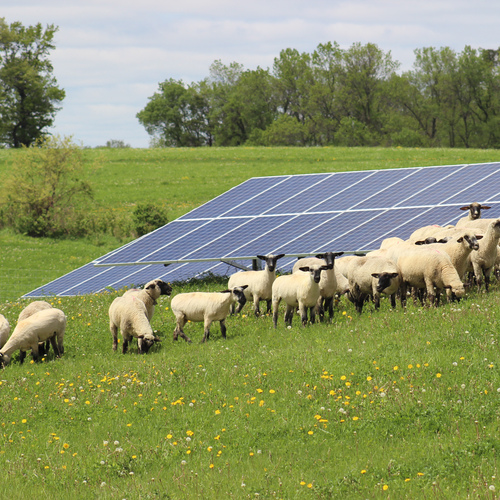
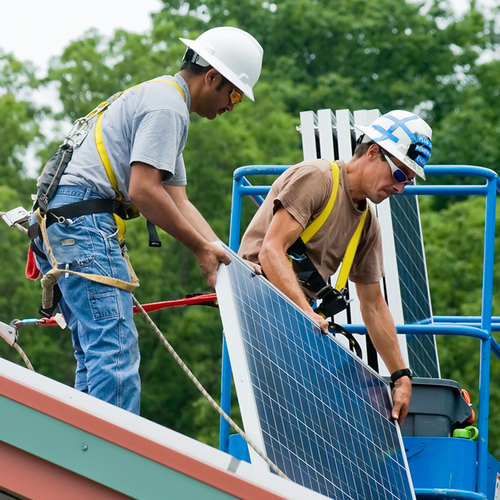
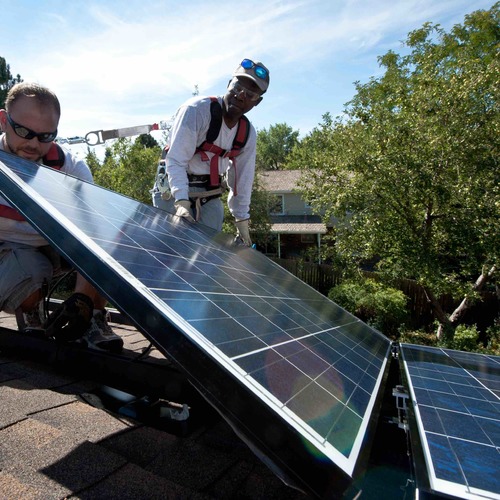
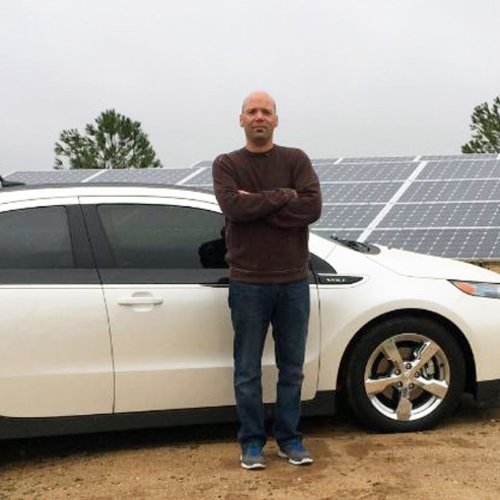






16 Comments
Not totaly sure what this means..
I didn't get a clear sense of what percentage of the power generated is affected by this change. Is this only going to affect the excess generation above the buildings use or will the lower rate be applied to all the energy, in which case it seems possible that the house could end up being billed even if it produces more than it consumes.
It seems wrong to pay if you are making more than you use, but it also seems a little unbalanced to force a utility to pay a premium rate for the excess.
I don't know enough about the power business and the logistics of the grid to have an opinion about the fairness of charging some sort of fee for upkeep of the system. Sounds logical on some level.
I say its about time
Its crazy for utilities to pay retail prices for what is nothing more than another wholesale supply. Why should everyone else on the system suffer because someone wants to justify payback on their PV system? You might as well say that the cooperative has changed its policy of letting Mr. KonKol take money out of his neighbors wallets.
Cooperative's rates
Eric, thanks for raising this question. Jerry Van Someren, the cooperative's customer service manager, says the lower rate applies only to excess power--the electricity that is above and beyond what Konkol uses.
Yes it is about time
Mr Konkol should stop whining. If I am reading this correctly, he is already ahead $2,000 on a fee that other customers pay. This means the other customers have subsidized this gift. By the looks of this house he can apparently afford a nominal hit to his wallet. Solar power proponents need to be careful with the narrative. As an environmentally friendly public policy it has much room to expand and benefit all of us. Unfortunately virtually all of the benefits to date have gone to relatively wealthy homeowners (like Mr Konkol) via tax rebates and other incentives. Especially evident in CA, people of means are building and retrofitting mansions and the rest of us are subsidizing it. This is abuse, a perversion actually, of the intent of green incentives.
Fair Pricing
I see two costs of the utility. One cost is to generate power, and the other is to distribute it. Both costs are reflected in the bill. With the developing trend of customer-produced power, it seems like the fair way of billing would be to separate the generation and distribution costs, and apply customer-produced excess power credit only to the utility company generating cost, and leave the distribution cost equally divided between all users of the distribution system. A customer connected to the distribution system should share the cost even if they are not receiving or sending power through it. And also, the credit for customer-produced excess power should be the cost of production for the utility company.
The Bigger Picture
People are missing the bigger picture here. It's not just that the power companies are reducing their payouts to PV customers, they are also doing their best to reduce or eliminate future customers from choosing to go PV. It comes down to their profits. Power companies have taken notice to diminishing revenue due to homeowners going PV and also people conserving their energy usage due to the economy. In turn the power companies are now beginning to charge more per kWh, higher connection and surcharge fees, and they are eliminating PV rebates.
Efficient green building is a threat to the utility companies. Plain and simple. When energy usage declines, the power companies have to somehow bring in extra revenue to make up the difference. My power company just increased their kWh rate because they went crying and claimed that the recent surge in solar caused them to see revenue decreases and they needed the funds to maintain their infrastructure. Yet their infrastructure was not improved on and is still outdated.
To those who think the utility company is your friend and wishes that you build "green" homes is out of touch. The complete opposite is true. They are a profit driven company that wants you to build the biggest energy hog home you can.
Just 3 years ago the power company was providing a PV rebate of $3,000 per kW. Fast forward to 2013 and they are now only providing a PV rebate of $100 per kW. That 97% decrease is a hit to those looking to install solar PV in their homes. Why did the power company do this? Simple, they now realize that PV costs them long term revenue and will do anything they can to STOP people from installing PV. Of course they won't be blunt about it and will go about doing so by reducing rebates, increasing grid connection fees (as they did to the above homeowner), and reducing the payback rate for power created by PV that is sent back to the power company (as mentioned in the above article).
To those who are singing the praises of the power companies and patting them on the back for the policy and rate changes are in turn hurting the green movement. Utility companies don't want to "downsize" and they don't want to reduce their power generating capabilities. They want to grow and create more and more electricity, as this generates profits and keeps investors in the game. Reducing energy usage and downsizing is the goal of green building, the complete opposite of the business model of utility companies.
Whose side are you on?
Neither Side
Solar incentive programs are not working for the utilities or for the people lower on the rungs who stand to benefit the most. This is boutique green energy at its worst. Passivhaus, a good program, almost necessarily requires a PV commitment. Fine, keep at it, just don't expect others to help you pay for it. Two different arguments. The lions share of residential solar funding (tax incentives and rebates) assists people who really don't need assistance. I would rather see that money spent on weatherization programs for mid/lower income people, solar water heating (if cost effective) or small PV arrays, all of which are targeted to reduce the monthly bite and spread the savings beyond a relatively small group of well off true believers. Green is more than the latest technology, it is a mindset.
About that hookup fee...
"even the new [$28] fee won't be enough to cover the actual cost of providing service, which is an average of $40, Pendergast said."
That sounds distinctly like the utility's problem, bad business, and an orthogonal argument. If it costs $40 to be hooked to the grid, then by all means charge $40 to be hooked to the grid, and don't whine about solar customers in the process... If the utility chose to subsidize actual connection costs w/ per-kWh costs, then they will continue to have some users (the energy hogs) subsidizing others (the low energy users). Solar just happens to be at one end of that spectrum.
More on Fair Pricing
Ron says "the credit for customer-produced excess power should be the cost of production for the utility company" - but the utility is part of a grid, and they buy and sell power all the time, and not at one fixed price. Peak power on an August afternoon might be pretty pricey - should solar be paid that price if it's generating at that time? There are efforts being made in MN to look into all this and determine a true "value of solar" which the solar proponents, of course, believe will be quite attractive. It'll be interesting to see what comes out of it.
I'm not singing..
..any praises to the power companies, I just think that the arrangement has to make economic sense for everyone involved, or it will be impossible to maintain. Here in Massachusetts I won't get paid anything for my excess production. I'll benefit from the states SREC program for 10 years, but I see that as a way the power companies are trying to bribe their way out of net metering. Certainly utilities are interested in defending their tidy little monopolies.
Whose side am I on?
This sort of "you are either for us or against us" stance is a plague in the green community. Whether it be discussions over Passive House costs or PV installations, we are constantly being told to just be true to the cause and not ask the sort of questions that might be uncomfortable for the proponents of these new, very promising, ways of building. Surely the best way forward is to stay clear-eyed and really look at these issues in a dispassionate way, not just tow the line because it seems like the right thing to do?
Power Companies - Business Model
Utility companies business models are about growth, expansion, building larger power plants, getting more cash flow and revenue. Solar incentive programs were not a brainchild of the utility companies, it was brought on by the Feds. Solar incentive programs cut into the profits of power companies and they don't like it. So they are doing everything in their power to avoid providing incentives.
If one thinks that power companies are looking out for your wallet and for the well being of the planet, think again. It wasn't until they were forced by the government and EPA to start cleaning up their fuel source pollution. Prior to that they were dumping toxins into the air and streams because it cost them $$$ to clean up their by-products. They were not willing to clean up their coal smoke stacks because that would mean less profits for them. They were forced to clean up by the EPA.
Solar incentives programs purpose was meant to reduce our burden on nuclear power plants and coal plants power grids. The less electricity we use, the less coal is burned and the less nuclear energy is created. Who benefited? The planet and of course the homeowner. No system is perfect but PV is a good thing and using less grid energy is better for the planet. Of course this cuts into the business model of the utility companies and they hate it.
Whose side am I on? I am on the side for a cleaner planet.
So a monopoly is whining they arent making as much money
The monopoly say Oh we arent making as much money and have to had on that cost to the next consumer which isnt fair, do they really care NO.
They say it costs us $X to make and distribute power, and taxes for carbon creation/pollution, so are they adding into that the tax breaks they get, or the tax breaks for buying clear sustainable energy. No I doubt it because if the consumer knew how much they really made per KWH people would be more inclined to take the plunge to sustainable.
If there was a storage solution for excess capacity for use at night/cloudy days, why would you need the utilities at all. The development of a battery solution besides the current deep cycle battery technology would spell the end of utilities.
Im all in favor of screwing the utilities since they have been doing it us consumers from day 1
Step back -- remember this is a cooperative
There are big differences between the for profit investor owned electric companies and community run electric cooperatives. Cooperatives like municipally owned utilities are in general zero profit. The accounting books are available for the cooperative members to see, etc.
Cooperatives in most cases are not vertically integrated utilities, they buy power from other generators (or have small shares in plants), they pay for transmission line use, they run small offices with the administrative services as required by FERC. Smaller coop's often have higher base fees because they can't spread the administrative costs out on as many customers, $40 may not be unreasonable.
Remember the Scott Gibson verified that the lower rate applies to the excess power that is generated and not used by the owner. The question that I think may still need to be asked is when the "true-up" of the net power is done, is it daily, monthly or yearly?
In Washington State - the true up is done once a year, the utilities are not required to pay out for the excess generation. You therefore design the solarPV system so that you produce slightly less than you need - or- you give away FREELY the extra $10 excess electricity each year.
Coop's may have a monopoly, but the owners of the monopoly are also the cooperative members. While I think the $0..0275 - $0.0375 / kWh may be too low of an estimated for the avoided costs - the owner does have the ability to go back and see if they included avoided transmission line costs. Avoided LMP fees, etc. And he could put forward a request via a ballot to the other cooperative members to pay excess generation at a slightly higher rate - if he feels he can sell his neighbors that the solar provides sufficient environmental value..
This case is very different than the Arizona Public System (APS) in that they are an investor owned company, trying to always exceed a 10% profit - and their system is vertically integrated. They own all the generation, transmission and distribution system. For APS - roof top customers mean stranded costs that they can not recover. Meanwhile as the AZ debate continues - APS is planning on building out their own solarPV farms....
Cooperatives are Not for Profit
Great explanation Dennis.
In most Net Metered applications the homeowner is not reimburesed the retail value. The Net Metering period is typically 12 months after which the homeowner would be reimbursed for any Net excess energy they generated in the 12 month period. Paying the "avoided cost" which is the cost the coop pays the G&T for their power is most common. Why should the homeowners, or anyone else for that matter expect their neighbors to pay for them to get special treatment? Why should the power company pay a homeowner for distribution and delivery costs incurred by the power company?
What is wrong with you
What is wrong with you people. There is nothing wrong with profit. If you remember a few years back the auto makers were losing money and ready to go out of business. In do so it would have taken a lot of jobs.
Utilities need the proper income to too support its services. If the utilities cant balance their income and expenses then they too will go out of business. If the prospect of GM closing was bad what would happen if there was no power to a whole city.
You don't see any business buying at retail prices and trying to resell for the same price. It just doesn't work that way.
I don't see the payment to homeowners as shutting down PV. It will make the homeowner right size the PV and not rely on tax subsidies and overly generous payments to fund PV for the homeowner.
I wonder when the tax man will figure out the loss of tax revenue and how will they find a way tax what you generate for you own use. Will we be just as outrage with the government's PROFIT.
With PV you will need the grid or else everyone will have to their own storage system. I don't think persona storage systems would be environmentally friendly or cost efficient.
To an extent the utilities welcome PV but they shouldn't have to pay for them with rebates and excessive buy back rates. It is extremely costly to build new power plants and hard to get them built.. PV can allow them to get buy without new plants. It reduces peak demand and with the right balance can be a win win.
PV doesn't make electricity at night and is greatly reduced in winter months. We still need other sources of electricity. We need the utilities to have the funds to get greener in what they produce and to have viable electric companies.
There will need to be a shift in income as PV grows. It may be higher hookup charges to make up for lower profits from generating electricity.
Log in or create an account to post a comment.
Sign up Log in